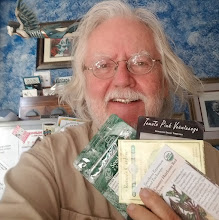A friend of mine shows off a Christmas Lima Bean, named for the bright red and white seeds. A productive Lima bean that persists right through our winters,'Christmas' is on my list of seeds that I hope SLOLA will save - what is on YOUR list?
Right now SLOLA (the Seed Library of Los Angeles) is in a formative stage and we have committees that deal with some things that aren't so interesting for most of us. We have to have rules/bylaws; we need to set standards and create protocols with structure – and we have to do it from whole cloth in order to make this vision of a seed library work and make it work for the generations to follow – if we set something in motion and fail to make it strong as an organization and institution, we could see all the work go for nothing if the seeds cannot be kept with pure genetic lines maintained and attention to all the little details wherein the Devil resides.
But... If you are at all like me, seeds are one of my playgrounds and I love to fiddle with them. When I'm not planting them, I'm dreaming about them and I'm making lists of what I'll plant later this year or what I hope I will be able to plant soon or maybe some rare heirloom that I can't find will obsess me for days until I either find it or give up trying. I grew up in Kansas and during the winter, with snow over the garden, I would page through the seed catalogs, memorizing the ones with the descriptions that captured my imagination, making long lists of the ones I wanted Grandpa to buy. He saved his seeds, so really never did take second note of my long lists, but I learned a lot from those seed catalogs and the fascination of a house-bound ten year old gardener for seeds is still with me today.
At the December meeting I asked everyone to come back to the January meeting (the 15th) with a list of 25 vegetable seeds they would like to see be a part of the collection of seeds that SLOLA offers. I hope you've been playing with this list; I have! I have about already over shot twenty five, so anyone needing additional suggestions, I'm ready to supply you with several to give you a full list!
But after I had made the list, I began to daydream about the future of SLOLA; a time when there is no real bylaws committee and the database committee is ad hoc, coming together only to solve a problem or to work out a better solution as warranted.
When that time comes, I see a Potato committee, a Lettuce Committee, a Pepper Committee and a Corn Committee and committees for every seed for which there is an interest in carrying on specific traits or creating newer cultivars. Each committee is looking at that plant and the different varieties available and perhaps even making new open-pollinated cultivars that improve the plants we can grow in the Los Angeles Basin. Perhaps in a few years, the L A area could be awash in the just-released “Bonilla Potato” or the “Spitz Red Leaf Lettuce!” Maybe there will be a super-productive red-skinned (and fleshed!) potato called “Rose Spuds” or a “Souper Soup Bean!"
The possibilities could be even more productive than the hybrids we see today – the only reason hybrids have become so much more productive than open-pollinated seeds is the amount of research that has gone into them – and that productivity has been at the expense of other, arguably just as important qualities, like taste or ability to grow and produce well in the micro-climate of the LA Basin. What has been done with hybrids can be approximated with open-pollinated plants. Corporations won't do it because there is no profit in it for them that justifies the research and trials – but a seed library can and should put efforts into breeding more productive stock for our areas.
But we will also need people who have mechanical skills to create appropriately powered machines to help us keep our seeds and make them even more available to more people. I have pondered for years the idea of a bicycle powered grain thresher, a device that would pound the wheat kernel free from the husk that holds it and winnow out the debris of the husk leaving a person with a wheat berries to be ground. Already my mind is turning to a similar contraption that will remove all the corn seeds from a cob without burning blisters into a person's hands.
It's not just wheat seeds that need threshing – several other vegetables can be hard to break out of coverings – and who knows? - maybe one day SLOLA will offer some varieties of wheat that do well in Los Angeles – or perhaps rice or other grain – they do comprise a large part of our diets.
But first veggies. Then I'm very keen on herbs – culinary and medicinal and flowers – edible and medicinal - and even those flowers that are not edible and 'only' good for the spirit, like my favorite, sweet peas. They are 'food for the soul' as some wise person a few years ago said.
The idea that one day we can have a small catalog of seeds available to members that will cover all the major vegetables and a few of the not so major ones as well, is tremendously empowering and exciting. I can't even think of this for a few minutes before I get all enthusiastic and I want to run out and plant another row of something that needs to be saved and dream of a future of a secure food supply, made secure by a few people who saw and acted on their uncommon common sense..
Times that are tenuous are often the times of greatest creativity. Certainly, in a turbulent economic time, faced with the greed of behemoth companies like Monsanto and others, a determined band of Los Angelenos came together to fight back the only way they could; by planting a seed of something that could grow.
I remember the old line: "Hope will never die as long as seed catalogs are printed.” Perhaps we can say, “Hope is ours to plant and harvest; we tend our own hope and hold our own destiny in our hands,” once again like our forebearers once did and we can claim their independence because of the seeds we have planted today.
Long live SLOLA!!
Here's MY current seed list of seeds I want to save first, subject to change as I think of more, in no particular order:
- Queensland Blue Squash
- Cannelini Bush Bean
- Flammé Tomato
- Tango Lettuce
- Drunken Woman Lettuce
- Merlot Lettuce
- Merville des Quatre Saison Lettuce
- Nutribud Broccoli
- Burpee's Golden Beet
- Five Color Silverbeet Chard (AKA Rainbow Chard)
- DiCicco Broccoli
- San Marzano Tomato
- Cherokee Tomato
- Pencil Pod Wax Bean
- Royal Burgundy Bean
- Parris Island Cos Lettuce
- Jalapeno Pepper
- Corno di Toro Pepper
- Scarlet Nantes Carrot
- Chioggia Beet
- Purple Top White Globe Turnip
- Copenhagen Market Cabbage
- Winningstadt Cabbage
- Country Gentleman Corn
- Golden Bantam Corn
- Garden Peach Tomato
- Fiber Flax
- White Cherry Tomato
- Gossypium arborense
- Gossypium hirsutum
- Gossypium barbadense
- Christmas Lima Bean
- Albino Beet
- Bulls Blood Beet
- Calabrese Broccoli
- Hutterite Soup Bean
- Mammoth Red Rock
- Early Snoball Cauliflower
- Bloody Butcher Corn
- Mexican Wedding Corn
- Stowell's Evergreen Corn
- Armenian Cucumber
- Long Red Florence Onion
Hope your list is just as long and varied and I hope we can have all of these in our inventory by this time next year... Oh.. And Merry Christmas (Lima Beans) to you and yours!
david







.jpg)